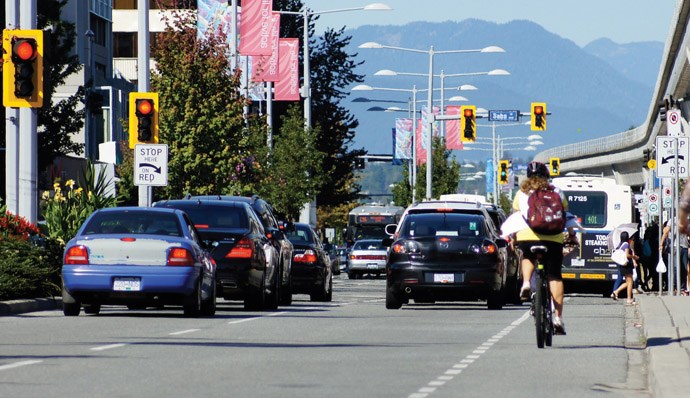If you’ve noticed traffic in Richmond has gotten worse over the last year, you’re not just seeing things.
Last year, according to ICBC data, the city added roughly 10,000 registered passenger vehicles to its roads.
In 2013, the city had about 100,000 passenger vehicles and by the end of 2014 that number ballooned to 110,000, as a result of development and a growing population.
Of all Metro Vancouver municipalities, Richmond’s numbers spiked the most (Burnaby, Surrey and Vancouver saw no change).
In the wake of regional transit funding hitting a concrete barrier — due to the failed TransLink plebiscite — the direction in which Richmond’s transit plan is heading should be a concern for residents, according to retired transportation planner and former Richmond resident Stephen Rees.
Rees pointed to new developments, such as the Oval Village, that have no realistic alternative methods of transportation other than cars.
“That amount of development and density is quite startling in an area that doesn’t have good transit. So that means people are going to be driving, I would think,” said Rees.
“You have to have services up and running so (residents) can see there’s an option. If all you have is a sign with a bus stop and no buses, well. It’s certainly unrealistic to increase transit ridership unless you can promise better services,” he said.
Presently, according to Richmond’s Official Community Plan from November 2012, 83 per cent of all trips by Richmond residents are done by car. The plan calls for that percentage to fall to 49 per cent by 2041, as part of its claim to become a livable city and reduce community greenhouse gas emissions.
Rees said if cities are going to densify, they need to ensure that density is within walking distance of mass transit (such as the Canada Line) or that there is frequent bus service (every 15 minutes or less).
The problem for Richmond is that TransLink is reducing services to bus lines that are not frequently used, Rees said.
City councillors were asked for their thoughts on how to reduce vehicle dependence, as well as how such rapid development could be justified without a transit plan in place.
Coun. Carol Day said she was concerned about the sharp growth in vehicle numbers.
“I feel we should invite representatives to come to a general purposes committee meeting to give the council and staff more detailed information in order for council to make educated decisions,” she said.
Her initial solution is to use older buses, as well as smaller ones, on less-used routes.
Meanwhile the City of Richmond responded to questions after its print deadline.
Spokesperson Ted Townsend downplayed the impact of the failed plebiscite.
“The recent plebiscite results may indicate slower pace of investments in transit improvements for the time being but the City believes it will not affect our ultimate goal and strategy over the longer term,” said Townsend.
He said the city would see vehicle numbers increase as development progresses.
“The number of cars in Richmond is expected to increase with the general growth in population but the objective is to minimize the rate of increase in vehicles and maximize the growth in other sustainable transport modes,” said Townsend.
Townsend said the city is improving pedestrian and cycling infrastructure as time goes on. He noted City Centre densification will be complimented by a new Capstan Way Canada Line station, paid for by development.
Meanwhile Richmond is set to start its regional transit plan, which has not been updated since 2000. The plan will include South Delta as well and Coun. Chak Au was recently named the council's representative for the process, which could take two years to complete from February 2015.
The city noted the process was delayed due to the plebiscite but time could be made up.
According to the Townsend, the plan is currently in Phase 1, which encompasses the identification of issues and opportunities. Draft strategies will be developed in Phase 2 (Fall 2015-Spring 2016) followed by the development of priority actions in Phase 3 (Spring-Summer 2016).
Actively Licensed Vehicles in Richmond in 2014 (2013)
Passenger: 110,000 (100,000)
Commercial: 14,000 (14,000)
Motorhome: 510 (530)
Motorcycle: 1,800 (1,900)
Hybrid: 1,900 (1,700)
Electric: 76 (21)
Source: ICBC



